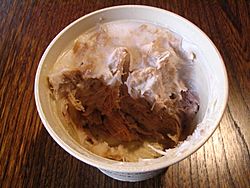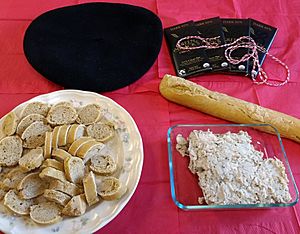Rillettes facts for kids

Rillettes du Mans
|
|
| Type | Spread |
|---|---|
| Place of origin | France |
| Main ingredients | Meat (pork, goose, duck, chicken, game birds, rabbit), salt, fat |
Rillettes is a special French way of preserving meat. It's a bit like confit, where meat is cooked very slowly in its own fat for many hours. After cooking, the meat is shredded into small pieces. Then, it's mixed with the cooking fat and packed into jars. This makes a thick, tasty spread.
Rillettes are most often made with pork. But you can also find them made from other meats. These include goose, duck, chicken, game birds, and rabbit. Sometimes, they are even made with fish like anchovies, tuna, pike, or salmon.
This delicious spread is best served at room temperature. People usually spread it thickly on toasted bread.
Contents
Where Do Rillettes Come From?
Rillettes are a famous food from central France. The areas of Sarthe (especially Le Mans), Tours, and Anjou are well-known for making them.
How Rillettes Are Made
Traditionally, rillettes were made using fatty parts of a pig, like the belly or shoulder. The meat was cut into cubes and salted. Then, it was cooked very slowly over low heat until it became super tender.
After cooking, the meat was pulled apart into small shreds. It was then mixed with the warm cooking fat. This created a rustic, chunky paste. People could store these rillettes in special pots for several months.
Over time, this cooking style was used for other meats. People started making rillettes from game birds, wild rabbits, and even fish. For fish rillettes, the fish isn't cooked in fat. Instead, it's blended with fat to make the spread. The smooth, soft texture is very important for good rillettes.
Different Kinds of Rillettes
Just like other famous French dishes, rillettes can be different depending on where they are made. Most rillettes are served at room temperature. They are spread on small pieces of toast, similar to a pâté.
- Rillettes from Tours and Anjou: These are known for being very rich and having a nice bronze color. This color comes from the long cooking process. A famous writer named Rabelais once called them "brown pig jam."
- Rillettes from Sarthe: These have a more rustic texture. This means they have larger pieces of pork in them. They also tend to be lighter in color.
In Quebec, Canada, there's a similar spread called cretons.
What Does "Rillettes" Mean?
The word rillettes first appeared in the French language around 1845. It comes from an older French word, rille. This word meant a slice of pork and was used as early as 1480. Rille itself is a variation of another old French word, reille. That word meant a thin strip of wood, which came from the Latin word regula.
See also
 In Spanish: Rillettes para niños
In Spanish: Rillettes para niños


